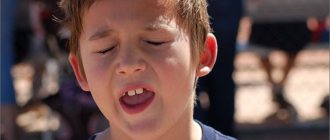Child psychologists have long urged parents not to show their children cartoons until the age of three. However, even after this, adults should monitor the content that the child watches. After all, children love monsters, of which there are so many in modern animation. How dangerous are these cartoons? Do they provide any benefit?
- 2 Danger to children's psyche
- 3 What psychologists and other experts say
3.1 Video: the influence of cartoons on a child’s psyche
- 3.2 Video: about the danger of monster dolls for children
Why do children like cartoons about monsters?
In the Russian language dictionary edited by A. P. Evgenieva, the word “monster” has the following meanings:
1. The one who (or what) stands out, amazes with its unusualness, its special properties, its structure, etc. 2. A person (or animal) with some. special physical disability, deformity; freak.
https://kartaslov.ru/%D0%B7%D0%BD%D0%B0%D1%87%D0%B5%D0%BD%D0%B8%D0%B5-%D1%81%D0%BB% D0%BE%D0%B2%D0%B0/%D0%BC%D0%BE%D0%BD%D1%81%D1%82%D1%80
Children who actively explore the world around them are attracted to everything unusual and incomprehensible. It’s not for nothing that many guys tell each other “horror stories” - stories about terrible mysterious creatures, ghosts, etc. And they do it with excitement, getting a dose of adrenaline.
Children are attracted to everything unusual, unknown, it’s not for nothing that they love to scare each other with horror stories
When a child plays, he often identifies himself with some creatures or characters. At the same time, he actively fantasizes, comes up with superpowers and desired qualities. This is why monster images in cartoons and their copies (anthropomorphic and zoomorphic) are so attractive to children.
What psychologists and other experts say
- Maybe the child likes some cartoons about monsters - so what?
- I mean that our child is always a reason for us to think about what to change in ourselves. A person must understand that nothing good can ever grow simply through prohibitions. We need to figure out why the child likes it, what’s good about it.
Sergius Kruglov, priest
On the road to heaven: a confidential conversation between a journalist and a priest
According to Western educators, children should get used to the fact that a monster with horns is kind, it also has a mom and dad, it is loved by its children, whom it takes boys and girls from the nearest kindergarten for dinner. Today's children get used to seeing cute monsters and empathizing they, when the real Monster comes at the end of time, will be greeted with sympathy and his point of view on the world will be accepted as possible. When the Terrible Judge of the Last Judgment comes and overthrows the Monster to judge the living and the dead for every word, deed and thought, the majority of humanity, accustomed to evil as an abstract fantasy, will simply want to switch the channel to something more fun. On "Shrek" or "Monsters, Inc."
https://mspros.ru/main?article=654
"Dead romance" can lead to seeking adventures in the cemetery, especially in adolescence. Again, after looking at the pretty dead dolls, children may wonder: is this what the dead really look like? And this is a direct path to vandalism, since children may try to dig up someone’s grave. And this is not the worst option, since the curiosity of teenagers can lead them to experiments like “what will I look like when I die?” And woe to the child if he has a company of equally inquisitive friends. You may have already heard these horrific stories about teenagers committing suicide or helping each other to do so.
Anastasia Dubrova, special education teacher
https://www.pravoslavie.ru/80671.html
Video: the influence of cartoons on a child’s psyche
Video: about the danger of monster dolls for children
Child draws monsters with teeth - psychology
Does the girl go to kindergarten? Do you admit that there may be conversations about “behave well, otherwise someone will take you away..”? Or whether she could have heard this in the hospital. Sometimes children are told anything to get the procedure done. Unfortunately..source
Wanting to understand their child, parents carefully look at his drawings. On the one hand this is good, but on the other hand it is bad. This article will help you learn everything you need about children's drawings so that this knowledge is beneficial and not harmful.
If children draw monsters.
Now that psychology is being actively popularized, all interested adults know that from children’s drawings one can understand what a child is thinking and how he feels. Wanting to better understand their baby and help him, many parents carefully and warily peer at his drawings. On the one hand, this is very good. On the other hand, it happens that the inept use of psychological knowledge causes harm. It traumatizes children and causes tension in their relationships with their parents. What do adults need to know about children's drawings so that this knowledge is beneficial and not harmful?
Children's drawings undoubtedly contain certain information about the life and experiences of their authors. But it is necessary to constantly remember that “life” and “experiences” are very broad concepts. Each children's drawing can be:
- an “instant photograph” of the child’s momentary feelings, an outburst of anger, resentment, embarrassment, love;
-expression of feelings, thoughts and states that are typical for a small person in certain situations: fear of the dark, concern for the health of parents, passionate affection for a hamster, etc.
- a reflection of the child’s picture of the world: the family consists of. holiday is when. war is when.
- the result of obediently following an adult’s instructions: what, how, where and what color to draw.
Children under 6 years old are more likely to draw their immediate feelings. It should be noted that these feelings can change right in the process of drawing, and a drawing started about “one thing” can be finished about “another”. Children over 10 years old, as a rule, solve painting problems in drawing. Moreover, the tasks are understood as student tasks: to draw a picture the way adults want to see it. The tasks of understanding the world and expressing their typical feelings through drawing are most often solved by children from 6 to 10 years old. However, more often does not mean always.
An adult who wants to draw conclusions based on a child’s drawing should definitely remember that regardless of the age of the author, his drawing can reflect any of the listed types of information or several at once. What the drawing actually reflects can only be determined by the child himself, unless, of course, he wants to tell. Children don’t always want to do this. By the age of 6-7, children begin to understand that they cannot always say everything to other people, including even those closest to them. Children from problem families master this truth earlier, the darlings of fate - later. But, in general, children over 6 years of age are in no hurry to disclose to adults those experiences that, as they know from experience, will upset, worry, or displease their parents. Having been doing art therapy with children for many years, we invariably at the end of classes offer them to take away any of their drawings if they wish. “Our clients prefer to leave problematic drawings, those that were associated with significant difficult experiences, to us. If a child draws at home, then, noticing close attention from adults, he begins to either hide drawings, which in his opinion may displease his parents, or makes them secretly. In some cases, children stop drawing at home altogether, which is undoubtedly a sad result of the “increased psychological literacy” of their parents. Many continue to paint at home, but become very diplomatic when answering questions. Their ingenuity and tact are simply amazing. For example, when asked why a child did not draw someone who, from the point of view of adults, should have been present in the drawing, children may answer that “there was not enough space”, that this person was “in the house” or “went to the store” and etc. The reasons given are usually innocent, convincing and plausible. Adults need to respect the child’s reluctance to discuss certain drawings or answer certain questions. In a sense, children's drawings can be considered an analogue of sheets of an adult's personal diary. Imagine that someone persistently tries to look into your diary and ask you about something that, after reading, does not seem clear enough to him.
If you still consider it necessary to understand “one hundred percent” what your child is drawing, carefully weigh your strengths. The information you get from a child's drawing can traumatize you. Are you ready to accept the fact that the father who left the family long ago, from whom even alimony can be obtained only through the court, remains the most dear person to the child? Can you accept the fact that from time to time you personify a witch for your baby? Will your new knowledge harm your relationship with your child?
Adults looking at children's drawings should definitely remember the folk wisdom: “Not every bastard fits the line.” You don’t need to focus your attention on every child’s thoughts and feelings. Remember yourself at some moments of your life. What would happen if someone looked into your thoughts back then? What would he think? How would your relationship with this person develop next? In any case, if you discuss his drawings with your child and want to interpret them, you must follow three rules: remember that the characters in the drawing are just characters; don't confuse them with real people. In the drawings completed within one hour, the mother can appear as a fairy, a witch, a fashion model, a female pilot and a queen. These are all different aspects of her image. But not a single character merges with her completely.
-The situation depicted in the picture may closely resemble the child’s real life situation, but it is still a fictitious situation and should not be confused with the real one. If in a drawing a character who looks like your son drowns his little brother in the bathtub or kills his stepfather, this does not mean that your child is going to take such actions in reality, although, of course, it speaks of some of his feelings. Please note that the baby may experience other feelings towards real people that are not reflected in this particular drawing. Children quickly learn to understand the difference between fantasy and real life. It’s all the more ridiculous for you, an adult, to forget about this difference.
- Never talk about the feelings, thoughts and actions of real people. As a last resort,
We can say that some events in the picture remind you of certain events from real life, are similar to them. Typically, manuals for psychologists list a number of specific signs that are recommended to pay attention to when analyzing children's drawings. But it is the specialists who know well that all these criteria can only play a supporting role. They must be interpreted very carefully and always taking into account the context. After all, for example, the color black does not always express negative emotions. This is a very “strong” color. The mark it leaves on paper is brighter than any other. This is what attracts many kids to him. In this case, black serves as an expression of strength and energy. In addition, the child can use one color or another in the drawing, imitating his neighbor. He may simply not have another pencil at hand or it may be broken. The color black can be used in an unconventional way as a result of the child's personal experiences. One six-year-old girl painted all the flowers black. This greatly alarmed the teachers. After questioning the little girl, they learned that she had seen black tulips at her friend’s dacha. These tulips struck her imagination and seemed very beautiful and unusual. First of all, when analyzing drawings, both the specialist and parents need to focus on their own immediate emotional impression of the drawing and how it relates to what you know about the child and his life situation. If in children's drawings everything is correct from a formal point of view, but for some reason the drawing leaves a feeling of anxiety, melancholy, tension, etc., this should alert you. An adult should also be wary if the child’s drawing is ideal and pleasant to look at, but it evokes a feeling of burning inconsistency with the real life situation. (For example, a child whose parents have a difficult divorce depicts a cheerful and friendly atmosphere in the family). On the contrary, if your child prefers to work with a black felt-tip pen or a simple pencil, but it is pleasant to look at his drawings, then there is no need to worry. (The same applies to drawing monsters, military equipment, etc.)
We advise you to read: Dream Interpretation the lower front tooth fell out without blood or pain
In any case, no matter what sensations a particular drawing evokes in you, it cannot yet be a cause for serious concern. You should worry and think about contacting a psychologist if:
- the child’s behavior changed for the worse (for example: he began to have trouble falling asleep, woke up from nightmares; became whiny or aggressive, unusually touchy, unsociable; lost interest and taste for life, began to study worse);
-many of the child’s drawings, when viewed, evoke unpleasant emotions in you, which we wrote about above;
If your child's behavior and drawings bother you, you should not think that by correcting the drawings you will help him. Unfortunately, many parents do exactly this. “Why did you paint everything black? This is ugly, better take a blue felt-tip pen,” “Let’s draw a smile on this animal, let him be kind,” they say. Helping a child and correcting a drawing are completely different things. To help the baby, you need to take care of him directly. What is his psychological burden? How does he experience what is happening in the life of his family and the world? Help the child, pay attention to him, try to solve his life problems - and the drawings will change themselves.
If an adult simply “edits” children’s drawings, he will only aggravate the child’s problems. The baby will still be tormented by the question of why dad left, afraid of the dark and angry with mom for unfair punishment. But in addition, he will lose the opportunity to alleviate his condition by expressing his pain, fear, anger, unquenched thirst for love and other emotions in drawings. As a result, negative emotions will find another way out: whims, fights, bad sleep, etc. Therefore, no matter what the child draws, do not insist on changing the drawing. You can express your opinion and feelings about the unfolding events or individual details of the drawing. You can make suggestions about what the character should do to get out of a difficult situation. But you should not persuade the child to redo the drawing or apply any sanctions, for example, prohibiting him from watching TV or playing on the computer, explaining that it is because of this that he has only monsters and bloody showdowns on his mind. The article provides examples of children's stories based on their own drawings. These are stories of absolutely normal, healthy children. However, some adults may find them a little unusual and perhaps even shocking. The fact is that these stories are very sincere and spontaneous. The child opens up in them to the end, without looking back, without fear of being misunderstood or judged. The authors of the texts cited were confident that they were in an environment where they would be understood. Such stories are strikingly different from those correct “stories for others” that children come up with in order to please adults, so that they do not worry and lag behind them with their moralizing questions. Is this how your children tell you about the content of their drawings? Or do they use stilted expressions, standard images and plots? Such “slickness” is an indicator that the child does not reveal his soul, although, of course, we are not talking about any deliberate lies.
“Hoop” education, child, student. No. 2 - 2006, p. 17.
source
How do you understand that a child can already draw and it’s time to give him paint? How to choose a teacher if you decide to teach your child drawing? Should I collect children's drawings? And why do some children draw with a black felt-tip pen, while others do not? Dmitry Ostapchuk (working under the creative pseudonym Dikson), founder of the social project “We Give You Art,” talks about how to raise an artist from a child.

Dmitry Ostapchuk, painting
—Are children born artists or do they become them?
— Geniuses and talents are born, but in addition to talent there is also skill. This skill can be developed through constant practice. And even a talented artist must develop his technique every day.
— At what age can and should a child start drawing? It happens that parents say: “Where should he draw, he’s still small.”
— Of course, in order to start drawing, there are no restrictions. The only thing is that you need to select materials according to age. Keep in mind that small children strive to taste everything. The main thing in any process is the safety of the child. Let them start drawing with their hands and fingers, gradually moving on to “adult” tools.
— How to recognize a child’s desire to draw, his readiness to draw?
- It is very simple and noticeable to the naked eye. First, children draw food on the table. If you give such a child paints, he will smear them too. Chances are he will like it. Children strive to do what they like.
You need to observe what the child shows interest in, and if he draws with pleasure, then you can develop this skill. The child should always have access to art supplies. So that he can draw at any time without asking. So that creativity is not associated with prohibitions and conditions.
— How do you feel about drawing schools? And how do you see an ideal teacher in an ideal art school?
“I have a very good attitude towards good schools, where children are not drilled into the heads of the dogmas of academic drawing from the cradle, but are helped to reveal the child’s talent through an individual approach. In the learning process, the personality of the teacher and his method are very important.
For me, the ideal teacher is Arkhip Kuindzhi. Who could teach each of his students to see the true colors of the world around them and transfer them to the canvas.
And for children, this should be a person who will not try to make them copies of himself, but will be like a gardener who takes care of flowers, but gives everyone the opportunity to grow naturally - to rise to their own height, to bloom in their own time, to have their own color.
But at the same time, observe ethical norms and rules, understanding that not all children’s interests may be beneficial for them. If a child wants to draw horror films or scenes of aggression, the teacher must be able to turn his interest to beauty and harmony. An ideal teacher must subtly feel this line so as not to suppress originality and instill interest in positive creativity.
— The child draws enthusiastically. What creative materials to choose?
— Try, if possible, to buy high-quality brushes and paints, because due to poor paints and brushes, there may be no desire to try to convey the beauty of the world in color, and the ideas that are born in the head may turn out to be unattainable by available means. Unfortunately, I notice that children's art products are often produced of poor quality: apparently, they think that for a child it will do just fine.

Dmitry Ostapchuk, graphics
— What advice would you give regarding flowers? Why is there no black in your paintings?
— When I give children sets of felt-tip pens, pencils or paints, I always throw away the black copies and give them without them. The reason is that I myself had to wean myself from using black pigment in painting for a very long time. The artist must be able to obtain the desired tone by mixing the colors of the spectrum. High level of skill - obtaining the desired shade without mixing black pigment. Black makes the job very easy, but gives a dirty tone.
Yes, children are happy to choose any contrasting colors for the drawing. The easiest way to achieve contrast on a white sheet is to use a black felt-tip pen, pencil or paint. The trick is that, getting used to achieving contrast with black, the child misses the opportunity to work with halftones and try to create a shadow using a more complex method. And if you remove black from the palette, then the child will be forced to achieve contrast with the ratio of other colors.
This will give him the skill of working with halftones, with shades, long before he begins to consciously approach the creation of a drawing. In the future, having matured, the child himself will complement the palette, but let it be a conscious choice.
— What about graphics? In your graphic works you use black Chinese ink and a felt-tip pen.
— In graphics, especially in contour graphics, in which I usually draw, contrast is necessary. I like traditional Far Eastern painting and graphics, and there black ink is a classic means of expression. However, even when drawing in this technique, I cover the black lines with strokes of gold or silver paint, reducing the percentage of black on the sheet of paper. When an image is dominated by black strokes or blur, it appears dark. It is necessary to maintain a balance of dark and light in the drawing and teach this to the child.
— Sometimes parents say that their child really likes to draw in black. How should we feel about this?
“In such cases, I say that there is no such thing as black joy, and if a child chooses black for drawings, then it may very well be that the child is stressed. There are also cases when parents impose black on their child when choosing clothes or a stroller for him. They lead by example, giving preference to black in clothing or interior design.
— Where, in your opinion, is it better to start introducing a child to art and what is the role of adults - parents, grandparents in the development of children's creativity?
- From a personal example. Children love to imitate, so if adults draw with great diligence, children will show interest in it.

Dmitry Ostapchuk
It is good to teach children to notice the details and nuances of nature. Examine leaves, blades of grass, draw their attention to the shape of trees, stones, the texture of the bark and try to sketch it together with them. And then carry out a joint analysis - whether it is similar or not similar to the original, what worked and what didn’t.
Discuss their work with the children. Ask them to talk about what they drew. Do not hurry. Don't compare them to other children or adult artists. Do not laugh at inexperience and ineptitude, remembering that with one careless word you can forever discourage creativity.
Adults should have patience and understanding of what all this work is for. In short: fine arts classes contribute to fine-tuning the visual apparatus, the ability to distinguish between halftones, observation, perseverance, concentration, development of imagination, and motor skills. And all this helps the development of brain functions.
You should take your children to museums and exhibitions of high-quality classical art, so that from early childhood they can see masterfully executed works. It is necessary that catalogs on art and books on drawing techniques be available so that the child can look at the pictures. You need to talk to your child about the pictures, ask him to describe what he sees, and come up with a story.
— What would you wish to the parents of growing artists?
- Praise them for their diligence and encourage them to strive for quality in their drawing. Appreciate and collect their works to track the dynamics of development. Demonstrating to children their achievements and their interested position. It is important for children that their parents become their first collectors. For them this is more important than any words.
Interviewed by Lianna Khostikyan, art critic, specialist in Japanese art, pediatrician
source
- Copyright holders
- Privacy Policy
© 2020 Attention! The information published on the site is for informational purposes only and does not constitute a recommendation for use. Be sure to consult with your doctor!








